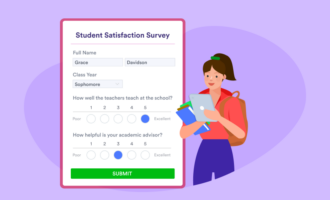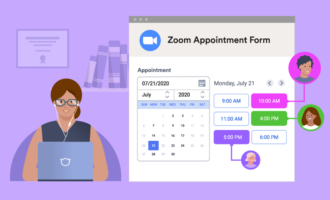How evaluation in education works
- Standardized testing
- Formative assessments
- Summative assessment
- Interviews and focus groups
Evaluation plays a critical role in every industry, company, and institution — helping stakeholders determine how effective their current approach is in helping them achieve their desired goal. Are processes efficient? Are current strategies delivering progress? Are people meeting expectations? Evaluation provides a framework for answering these questions and gaining the insight needed to make changes.
Evaluation in education is a way to gather and analyze data about individual students that paints a picture of their overall academic performance — particularly in terms of their long-term development. It goes beyond grades and grade point averages to look at proficiency in different areas over a period of time.
Of course, when there’s so much data to collect and manage, conducting an evaluation in education is a complex process that requires the right tools. Read on to learn more about what evaluation in education really is, how to properly execute it, and which software can help.
How evaluation in education works
Evaluation in education is a multistep process that first requires gathering data about student performance and, later, analyzing that data. Educational institutions can collect this information through a variety of methods:
- Standardized testing: Schools use standardized tests to assess students’ academic performance and compare it to relevant benchmarks. These tests help measure students’ knowledge and skills in specific subjects. The SAT and ACT are some of the most well-known types of standardized tests, administered by states and graded according to benchmarks determined by state and federal data.
- Formative assessments: This method involves ongoing assessments, like regular quizzes or homework assignments. These assessments are designed to provide feedback to both students and teachers about learning progress and areas for improvement.
- Summative assessment: This type of assessment takes place at the end of a semester, unit, or course and evaluates how much students actually learned and retained. Examples include final exams and end-of-year assessments.
- Interviews and focus groups: This method provides valuable qualitative insights into the strengths and weaknesses of a given educational program, often leveraging insight from students, teachers, administrators, and parents.
Why evaluation in education is so important
While these evaluations measure student progress, administrators can use that same data to draw conclusions about their overall approach to educational programming and make changes at their institutions where necessary. Here are some of the biggest benefits of conducting evaluations in education:
- Improved student success: Assessing students’ learning outcomes and understanding their strengths and weaknesses helps educators better tailor instruction to meet their individual needs. This provides an opportunity for educators to intervene when a student is falling behind or not meeting benchmarks, leading to greater student success and academic achievement.
- Higher-quality educational programming: Evaluations in education can measure the effectiveness of teaching methods, curriculum design, and learning resources. This feedback allows educators and policymakers to identify areas for improvement and make informed decisions about how to provide higher-quality education.
- Enhanced accountability and transparency: Evaluations help hold educational institutions, administrators, and teachers accountable for their performance and the ways they use their time and resources. If only a low percentage of students achieves desired test results, that should prompt administrators, teachers, and other stakeholders to take corrective action and make necessary changes.
- Better resource allocation: Evaluations help identify which educational programs and interventions are most effective. With this knowledge, policymakers and administrators can allocate resources where they’re needed to maintain current standards and improve outcomes in the future.
- Improved teaching practices: Feedback from evaluations helps teachers reflect on their instructional methods, classroom management, and student engagement. This encourages professional growth and continuous learning among educators.
How to implement an educational evaluation process
Evaluation in education comes in various forms, but all of them have a similar implementation process. Here’s a high-level, step-by-step process to follow:
- Establish objectives. First, determine what type of information you want to obtain from the evaluation, such as students’ academic performance, subject-specific knowledge, or learning progress over time.
- Select an evaluation type. Choose a test that most closely aligns with your objectives, is reliably effective, and is appropriate for the age and grade level of the students you’re assessing. Consider using nationally or internationally recognized tests or collaborate with experts in test development if needed.
- Create an administration plan. Develop a detailed plan for test administration, including the schedule, location, and logistics. Ensure that testing conditions are consistent and fair for all students, and provide adequate time for both teachers and students to prepare.
- Collect the data. Once you’re ready, conduct the evaluation and collect all relevant documents from students.
- Interpret and report findings. Follow appropriate guidelines for evaluating test answers, then analyze results within the context of your objectives. Individual test results will help students understand where they excel and where they still need improvement. Grade- and school-wide results will help educators and administrators understand where they need to allocate more resources or modify pedagogy to boost low test scores.
Why Jotform gets an A+ in educational evaluation
Evaluations in education involve a lot of complex data — and managing them effectively is difficult without the right software.
Jotform is a powerful online software with an intuitive, no-code interface, versatile features, and secure data management. The Jotform for education is specifically designed to cater to the needs of teachers and administrators, empowering users to create a wide variety of tests, quizzes, surveys, and other forms in an easy-to-share online format.
What’s more, Jotform’s template library includes dozens of customizable education templates to help with everything from administering tests to managing schedules. Through seamless integration with other platforms and robust data analytics tools, Jotform allows educators to efficiently collect and analyze test results, so they have more time to give students the one-on-one attention they deserve.
Photo by Thirdman








































































































Send Comment: